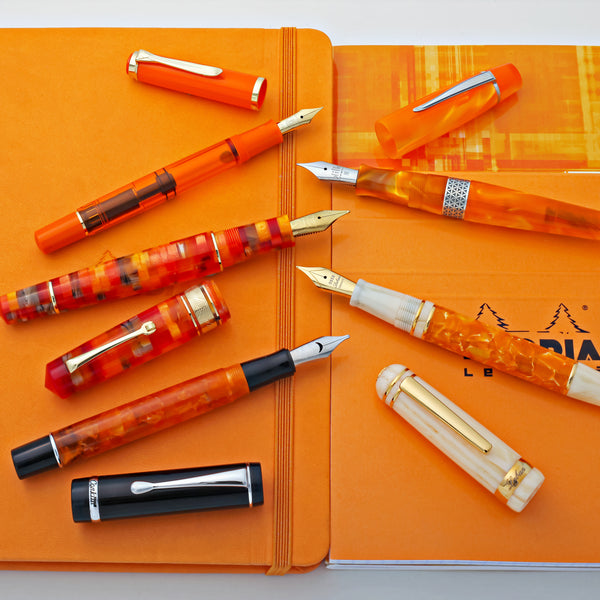The Fountain Pen Nib
The nib is the heart of the fountain pen and the fulcrum of the writing experience, a critical piece of technology to understand when learning how fountain pens work. The imprint will tell you important details, such as the manufacturer and metal content of the nib. Gold nibs are struck with 14kt, 18kt or 21kt to designate the amount of gold content. A 14kt nib will have 58.5% pure gold and will often read "14kt <585>." A stainless steel nib will not have such a hallmark. Most nibs will have an engraving of the point size - EF for extra fine, F for fine, M for medium and so on. Sometimes, the nib size is engraved on the side of the nib or imprinted on the feed (Like the Aurora Optima or 88).
If your nib feels scratchy or skips while writing, you may have a nib alignment issue. To visually spot this issue, use a loupe or magnifying glass to examine the tipping material. From the front view, the tipping material should look like a sphere split in half. If both sides of the sphere don't match up, then the nib is out of alignment. Experienced fountain pen users that adjust and tune their own nibs can easily remedy the problem. If you have trouble using your pen and spot this problem, contact the shop, the respective manufacturer or a professional nib repair specialist (lovingly called a "nibmeister").
The slit of the nib carries ink from the feed's ink channel to the tipping material. Looking at the nib top-down, the width of the slit should taper from its start point at the breather hole all the way to the tipping material. Although most do, some nibs do not have a breather hole.
The Fountain Pen Feed
The feed controls the flow of ink from the main reservoir (supplied by a cartridge refill, converter, piston-mechanism, etc.) to the nib by capillary action. Feeds are designed to keep a steady stream of ink while you are writing and prevent the pen from leaking when you are not. The moment you touch nib to paper, the feed is channeling more ink to supply each stroke. The fountain pen feed determines how you will fill the fountain pen with ink.
The Fountain Pen Section
A fountain pen's section contains all the functional components, including the nib and feed. It is also the part that is usually gripped while writing. The housing is usually screwed into the section. The nib and feed are friction-fit into the housing. The fit should be snug to prevent any accidental leakage.
The Fountain Pen Barrel
The pen barrel is like the "handle" of a pen. Inside, it contains the ink reservoir, like an ink cartridge, converter, or piston-fill mechanism, etc.
The Fountain Pen Cap
The cap keeps your pen from drying out and protects the nib while not in use. Sometime's called a "lid," the cap can either screw-on, snap-on, twist-lock, or magnetically attach. Most caps have a functional pocket clip that attaches to a thin piece of fabric and prevents the pen from rolling off a desk.
Fountain Pen Ink Cartridge
The fountain pen ink cartridge is a plastic-walled ink capsule. It usually narrows at one end, where the mouth (or nipple) can be pierced by the back-end of the feed. Although cartridges are designed to be disposable, some opt to clean out and refill them using a blunt needle syringe. You can learn more about ink cartridge and converter compatibility with our guide here.
Parts of a Fountain Pen With Ink Converter Filling Mechanism



